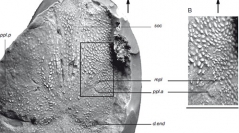

 Geodiversitas
33 (3) - Pages 393-409
Geodiversitas
33 (3) - Pages 393-409An exceptionally well-preserved new acanthothoracid (placoderm fish) presenting complete endocranium and skull roof, from Saudi Arabia (Qasr Limestone Member, Jauf Formation), Early Devonian in age, is described as Arabosteus variabilis n. gen., n. sp. Compared to other Acanthothoraci, the new taxon exhibits a skull roof variable in its dermal plate distribution (e.g., a supernumerary plate: the posterior central plate) and sensory line pattern. Even the different specimens of this taxon show such variability between them. Arabosteus variabilis n. gen., n. sp. enlarges the scope of our knowledge of Acanthothoraci and Placodermi in general. Traditionally, the Arthrodira, one of the historically earliest described groups, provide the standard reference model for the placoderm skull roof pattern. The interpretation of the acanthothoracid skull roof pattern of the Saudi taxon from an arthrodiran model and the establishment of homologies is impossible to resolve unless based on prior assumptions (e.g., hypothesis of fragmentation or fusion for the paranuchal plate complex). The lateral line system of A. variabilis n. gen., n. sp. is unstable (e.g., presence or absence of the postmarginal sensory line canal) making it ambiguous to define bone homology and terminology. Consequently spatial distribution of skull roof plates has been retained for such a task with a minimal reference to the instable features of the sensory line groove distribution.
Acanthothoraci, Placodermi, Arabosteus variabilis n. gen, n. sp., arthrodiran model, endocranium, homology, skull roof plate, Saudi Arabia, new genus, new species